Abstract
Optical Camera Communication (OCC) is an emerging technology that has attracted research interest in recent decades. Unlike previous communication technologies, OCC uses visible light as the medium to transmit data from receivers and cameras to receive the data. OCC has several advantages that can be capitalized in several implementations. However, the Internet of Things (IoT) has emerged as a technology with immense potential. Numerous research endeavors support the IoT’s prospective technology that can be implemented in various sectors, including the healthcare system. This study introduces a novel implementation of the Internet of Medical Things (IoMT) system, using OCC for real-time health monitoring and indoor location tracking. The innovative system uses standard closed-circuit television CCTV setups, integrating deep learning-based OCC to monitor multiple patients simultaneously, each represented by an LED matrix. The effectiveness of the system was demonstrated through two scenarios: the first involves dual transmitters and a single camera, highlighting real-time monitoring of vital health data; the second features a transmitter with dual cameras, focusing patient movement tracking across different camera fields of view. To accurately locate and track the position of LED arrays in the camera, the system used YOLO (You Only Look Once). Data are securely transmitted to an edge server and stored using the REST API, with a web interface providing real-time patient updates. This study highlights the potential of OCC in IoMT for advanced patient care and proposes future exploration in larger healthcare systems and other IoT domains.
1. Introduction
Optical Camera Communication (OCC) is a subset topic of Optical Wireless Communications (OWC), which involves the optical spectrum to transmit and receive signals. OCC is the development technology of visible light communications (VLC), which is performed using LEDs and photodiodes as transmitters and receivers. Instead of using photodiodes as receivers, OCC uses a camera as the receiver, while on the transmitter, various devices can be used, such as LEDs or even digital signage [1].
Several sophisticated technologies have been developed and technological definitions have been found in recent years. The Internet of Things (IoT) is one of the trending terms that has diverse meanings with one goal, defining a paradigm where things are interconnected, capable of communicating with one another, and can be adjusted over time for users’ needs as well as work autonomously to exchange data between entities [2]. The idea of IoT can be traced back to 2005 when the meaning of IoT was to integrate technology into human’s everyday human life [3]. Previously, radio-frequency identification (RFID) was the only technology that was considered to be a communication medium that was able to perform IoT [4]. However, IoT can consist of various sensor devices and communication interfaces deployed in local or even separated areas currently. The gained data are processed using advanced algorithms to obtain deep insights and information depending on the target of the IoT system [5]. In addition, from these diverse data, a better understanding and insights can be gained for some actions or prevention that can be applied to the IoT system installed area [6]. Furthermore, with the advancement of recent technologies, IoT systems are currently supported by several sophisticated technologies such as edge computing that enables IoT systems to generate decisions and interact between sensor devices in real-time processing [7].
Concurrently, IoT has been implemented in various fields, including the industrial field known as industrial IoT [2]. The IoT system is adjusted based on the industry’s characteristics. For example, in terms of sensing devices used, agricultural industries use different sensing devices than the basis of industries used in construction industries [5]. In agriculture scenarios, the sensor devices used are those that function to monitor crops and plants, such as light sensors, temperature sensors, and soil moisture sensors [8]. In the construction industry, most IoT data are collected from vibration sensing systems, which include various sensor devices such as a triaxial gyroscope, triaxial magnetometer, and triaxial accelerometer [9]. Another implementation is in security systems, where the IoT is used to enhance security in homes or public facilities. Early implementations used cameras as sensing devices and connected them over a local area network (LAN) system [6]. However, surveillance of an indoor building or an outdoor environment can be performed not only over a LAN network but also from remote places due to the increasing ability of internet technology to process the data [7]. For example, in smart home applications, a camera installed inside the house can be tracked through the internet server or cloud from smartphones or tablets [3]. In the medical field, or the Internet of Medical Things (IoMT), more efficient and faster processes in healthcare systems are urgently needed. In addition, increasing health costs from year to year are also transforming into other problems. Therefore, technology development and its use play a significant role in improving the healthcare system [10].
Despite implementations in various fields, the IoT has its base architecture, although it is yet to be standardized. However, the base architecture is derived based on the process similarity among the IoT system implementations [4]. Considering the existing systems, IoT architecture can be divided into five main layers: sensing, communication, cloud, management, and applications layers [11]. As aforementioned, knowledge or data is gained through sensing devices. Therefore, the sensing layer can be regarded as the first layer in the IoT architecture. This layer consists of sensor networks and embedded technologies, also considered the slowest layer compared to other layers [12]. Above the sensing layer is the communication layer, and its task is to bridge and manage the communication between the sensing and upper layers. These layers include routers, switches, and other similar devices and use several protocols such as CoAP [13] and Message Queueing Telemetry Transportation (MQTT) [14]. The cloud layer is the one-level layer above the communication layer and as the name implies, the cloud layer utilizes cloud and edge computing technologies. In the cloud layer, data are processed and analyzed to obtain more insights, and information and decision-making can be performed [15]. Cloud technologies are currently equipped with artificial intelligence technologies to enable autonomous decision-making [16]. The management layer is responsible for monitoring other layers so that actions can be taken if faults or errors occur on those other layers. Finally, the application layer can interact with end-users directly. It provides applications and services for end-users so that all processes in the IoT can be operated within human control [11]. As illustrated in Figure 1, this architecture forms the foundation for diverse IoT implementations, providing a flexible yet structured framework for various IoT applications.
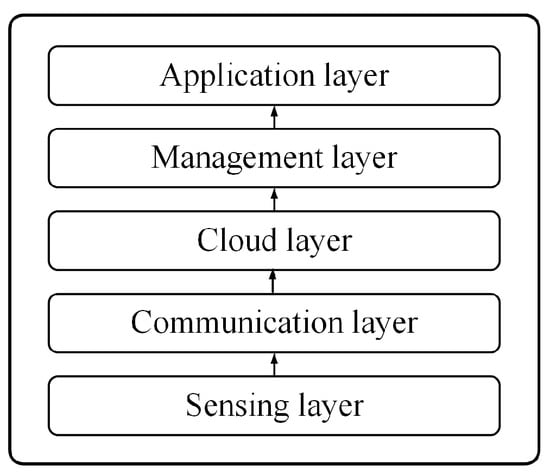
Figure 1.
IoT architecture layers.
As aforementioned, one of the IoT applications is in the medical field. Notably, there are many specialized fields in IoMT. However, one of the trending research projects regarding IoMT is the development of a Wireless Body Area Network (WBAN) [17]. WBAN aims to provide continuous and automated monitoring of patients as well as insights and knowledge that can be concluded by the medical staff; thereby, responses and actions can be performed more rapidly. Furthermore, WBAN is designed to obtain various data, such as temperature, oxygen saturation, and tension [12], directly from the patient’s body, making the health diagnosis more accurate [18]. In indoor scenarios such as medical centers or even hospitals, WBAN can be integrated with local or edge server systems to create an IoMT system that is robust and sustainable in providing data. Currently, RF-based signal communication technologies such as Bluetooth, Ultra-Wideband (UWB), and ZigBee are still widely used to send data from sensing devices in the body area to the upper layer of the IoMT system [19]. Figure 2 shows the illustration of WBAN, which presents a visual representation of how WBAN functions within the IoMT framework.
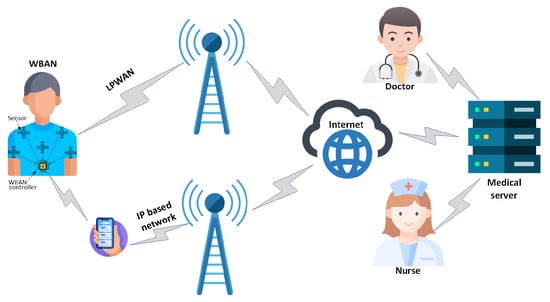
Figure 2.
Illustration of WBAN.
Despite the rising usage of RF-based IoT in medical applications, it has several disadvantages. Since the sensing devices are attached to the body, the communication device should also be located near the body. RF-based communication devices are commonly known to be harmful to the body in long-term usage [20]. This would be unhealthy for anyone, especially a patient with severe illnesses. Moreover, RF-based communication is prone to jamming and intrusion [21], resulting in unsafe users, which in advanced cases can lead to malicious threats or other cyber-attacks [22].
However, despite its potential as a new communication medium, OCC has several drawbacks compared to other communication technologies. OCC is dependent on camera specifications, with commercial cameras mostly having low frame-per-second (fps) rates. This problem can be overcome by using a more sophisticated camera. Additionally, in a non-line-of-sight (NLOS) situation, the communication performance deteriorates, unlike other communication modes. OCC requires high visibility on the transmitter. This issue can be addressed by using several cameras in an environment, improving the OCC system’s performance. While the transmitter may not be visible to one receiver, it might be visible to other cameras.
Therefore, in this study, we propose OCC as the WBAN communication method in the IoMT scenario. In our context, aligned with the aforementioned fact, security cameras such as CCTV are commonly installed in many buildings. Hence, OCC-based IoT can be implemented locally for those buildings. Using multiple cameras, every time a patient equipped with sensing devices connected to the LED transmitter passes through a CCTV camera or similar device, the LED matrix transmitter can be detected by those cameras and the data can be transmitted from the LED matrix to the camera. In this work, the use of the YOLO [14] object detection task is also proposed to detect the LED matrix for multiple user (patient) scenarios. Therefore, real-time and continuous monitoring of the patient using OCC is possible since installed cameras are available on every corner of the building and even in the building hallway. Therefore, the overall contributions of this study are as follows:
- An IoT system scheme using OCC is provided, taking advantage of the CCTV camera system that is common in every building in present days, especially in health centers or hospitals, to perform continuous and real-time patient health monitoring;
- Implementation of deep learning-based OCC on multiple patients. In the proposed scheme, object detection is used to receive data from multiple patients represented by the use of several LED matrices;
- Indoor real-time patient relative location based on camera locations. Using several cameras installed in the building for OCC, patient location can be determined.
2. Literature Review
In the context of OCC within the IoT, cameras play a crucial role in facilitating efficient data collection from a variety of devices and sensors. This OCC system is responsible for processing data received from multiple sources, and then transmitting it to a gateway via wired or wireless networks. Once the data arrives at the gateway, it is then routed to a backhaul network, such as 5G or satellite, and ultimately stored on a server or in the cloud, providing support for various IoT applications [23]. Several studies on OCC in the field of IoT include:
Ref. [24] proposed a new approach for OCC using side-emitting fiber transmitters and accomplished an increased communication distance two times that of previous research [25,26]. The proposed OCC-fiber link successfully fulfills the Fuel and Missions Calculator (FEC), Version 3.8 limit for Bit Error Rate (BER) on distances of 35 m (BER = 3.35 · ) and 40 m (BER = 1.13 · ) using fiber with diameters of 2 and 3 mm, respectively. The results show that the frequencies using on-off keying are 3.54 and 5.28 kHz each, which creates potential applications in IoT-based indoor and outdoor environments where OCC uses distributed fiber. However, there are some weaknesses related to the fiber, which has a limited radiation angle coverage compared with a conventional light transmitter. This possibly results in a more limited signal recipient zone, a restricted coverage area that can be reached by the OCC system. Furthermore, fiber usage limits flexibility, and it is possible to increase the implementation cost.
Another study proposed a hybrid wireless communication system [27] that combines OWC with direct modulation on LED chips. This system is designed for multipurpose indoor IoT using a single LED as a transmitter and a combination of photodiodes with the camera as the receiver. The experiment shows that the system can reach a throughput of up to 100 Mb/s for visible light communication (VLC) link and data transmission without fault for the OCC link. The result is reached using direct modulation with various amplitude levels, and optimization of the received optical power can significantly enhance the performance of the link. This research also explored various LED colors and sophisticated modulation techniques (direct modulation). Based on the results of the experiments conducted in this research, the obtained results pave the way for implementation in real-world IoT scenarios.
Another hybrid research [28] proposed the use of OCC in IoT systems to overcome RF spectrum density. This work proposed an IoT application with an 8 × 8 LED matrix to transmit temperature and humidity data through 2 packets/s with a packet error rate (PER) of less than 3% over a 2-m distance. The main problem of this implementation is the noise and interference possibility due to LED usage with different bandwidths from the VLC link. The results of the development of the SIMO hybrid VLC system can provide versatile indoor services for IoT. This is because the system can address RF spectrum density issues and successfully reduce interference and noise in the VLC link with an 8 × 8 LED matrix. In Ref. [29], a similar method, which is hybrid SIMO for optical IoT system, uses an LED-based transmitter and photodetector and Image Sensors (IS) based receiver for high and low data rate transmission simultaneously. Photodetector-based VLC is used to download large-sized data, internet browsing, and online streaming, whereas IS-based VLC is used to transmit short messages, identification information, and signal control. This hybrid modulation scheme with Rb-High up to 60 Mb/s and Rb-Low up to 5 kb/s is intended to increase the performance, and the experimental results are as desired. This scheme can be developed by adding a color LED for lighting, equalization technique implementation, and different modulation formats to increase the data reception success rate and BER performance. This study provides solutions for multipurpose indoor optical IoT regardless of the device used.
Furthermore, Ref. [30] developed efficient OCC for IoT applications to overcome the distance limit and low data rate on existing OCC implementations. In this work, the proposed OCC used an 8 × 8 LED matrix to increase the operational distance up to 2 m and to reduce BER, which is suitable for use in an indoor industrial environment. The main purpose of this research is to obtain an efficient classification pattern and widen the communication distance with a data rate of more than 256 bps. Based on the results, this study achieves efficient classification of 2D signal patterns on LED matrices and can detect the pattern from a far distance. However, there are several weaknesses, such as performance limitations on further distance and higher data rates. In addition, factors affect system performance, especially camera settings, and characteristics such as resolution and brightness, influencing pattern recognition and communication errors.
IoMT, as a subcategory of IoT, is still relatively unexplored in the healthcare context, particularly in the use of OCC. However, recent studies in the field of OCC for eHealth [20,31,32] have developed monitoring systems that enable patient surveillance in various settings such as homes, hospitals, indoor and outdoor areas, intensive care units, ambulances, airplanes, ships, and ICUs. OCC is applied to measure photoplethysmography (PPG) signals, analyze emotions, determine blood oxygen levels [32], and assist in patient diagnosis [20]. In OCC-based healthcare systems, data are collected from various LEDs worn by patients. This data collection is conducted securely and reliably without causing interference, ensuring high quality of service (QoS) [33]. OCC offers several advantages that can benefit the healthcare sector:
- OCC offers a wide spectrum, low cost, and lower system costs [20]. It also has no electromagnetic interference (EMI), which can lead to failures in medical devices [34];
- Visible light waves have no adverse effects on human health [35], and non-flicker technology in light waves can be used with modulation frequencies exceeding 200 Hz without posing a threat to human eyes, unlike the potential negative effects of RF waves on human health [36];
- The increased bandwidth in current communication systems often requires the use of higher-frequency waves, which can negatively impact human health [36];
- RF systems use electromagnetic waves to transmit information, which is potentially harmful to human health [20,35];
- OCC provides a readily deployable LiFi solution using a smartphone camera [37] for communication, positioning, indoor navigation, and augmented reality without the need for additional equipment such as photodiodes [38].
Based on various studies in the field of IoT, OCC technology exhibits significant potential as a reliable and versatile application for both outdoor and indoor environments. This enables effective and efficient implementation across IoT scenarios. Although the use of OCC in IoMT is still underexplored, there has been a significant increase in research within the eHealth context. To enhance continuous and real-time health monitoring of patients, particularly through remote monitoring, we developed an IoMT system scheme focused on indoor scenarios. This system integrates OCC-based WBAN using CCTV cameras, which are widely available in various buildings, especially in healthcare facilities or hospitals. We also considered important factors such as the capacity to serve multiple patients, system coverage, and the ability to monitor patients’ positions or locations simultaneously in different places, all of which are strengthened by the use of artificial intelligence.
3. Proposed OCC IoMT Platform (Design and Implementation)
The IoMT is the practical application of IoT devices combined with medical technology for healthcare, facilitating the transfer of data between devices and health applications. The implementation of OCC within IoMT involves the use of light signals and camera sensors to create a secure and fast data communication system. In practice, OCC enables remote patient monitoring and real-time transmission of medical data to healthcare providers. Figure 3 shows a block diagram of the IoMT OCC platform.

Figure 3.
Block diagram of the IoMT OCC platform.
Figure 3 shows the block diagram of the IoMT OCC form, and the process begins when the patient activates the health device. This process involves collecting data from oxygen, heart rate, and temperature sensors, which are vital indicators in health monitoring and are equipped with a panic button. A data encoder then encrypts the data collected by these sensors. This encrypted data is then transmitted through a matrix of LEDs using the On-Off Keying (OOK) modulation technique. Each LED has its own identity and acts as an anchor in data communication, allowing the identification of specific LED locations and ensuring the accuracy of the received data source.
The diagram also shows the process of detecting missing bits and decoding data, demonstrating an error correction system that ensures data integrity. The system also uses a camera to receive the encrypted light signals. Once the data is decoded, the system reassembles the data that may be divided into several packets, and then sends it to the edge server. This server acts as a bridge between IoT devices and larger cloud infrastructure, performing initial data processing, reducing communication latency, and enabling rapid response in emergencies.
Finally, the edge server sends the data to the IoMT platform, which can be accessed by healthcare providers. This provides the possibility for real-time patient monitoring, which is crucial for proactive and responsive healthcare.
3.1. Transmitter
The transmitter section utilizes an 8 × 8 LED matrix with OOK modulation. During the OOK modulation process in OCC, data transmission is managed through LEDs, altering the light intensity between two states: the LED is on to represent the “1” bit and off for the “0” bit. In operation, the 8 × 8 LED matrix consistently generates light patterns based on the sequence of bits received, which are then captured by an optical camera serving as the receiver. Algorithm 1 outlines OOK algorithm steps for mapping data received from each sensor onto the 8 × 8 LED matrix, which is subsequently modulated. The initial phase involves configuring pin parameters for the pulse oximeter sensor and LED matrix 8 × 8 and initializing serial communication. In this research, we utilized the MAX30102 sensor as the pulse oximeter sensor and the LED matrix is configured through Neopixel library. Moreover, anchor, LED ID, and sequence number are also initialized before transmitting the data. The program then enters a continuous main loop, reading oxygen saturation, heart rate, and temperature values from the MAX30102 sensor. In addition, it monitors the status of the panic button, detecting if it has been pressed.
| Algorithm 1 Pseudocode—“Transmitter” |
|
Subsequently, data from the MAX30102 sensor and the panic button status are transformed into a binary format. For each value of oxygen saturation, heart rate, temperature, and status of the panic button, a corresponding binary representation is created. Based on these binary representations, the “a” array is updated to determine which pixels in the LED matrix will switch states (on/off). Thus, each index corresponds to one pixel on the LED matrix. Following this modification, the on/off states of the LED matrix pixels are aligned with the refreshed values in the array. Furthermore, as initialized in the beginning, the sequence number (SN) along with an anchor and LED ID is assigned to the “a” array. Each process is repeated in the main loop. This process encompasses additional procedures for reading sensor values, including the panic button state, and functions for converting integer values into binary strings. The comprehensive pseudocode delineates the procedures for accessing, processing, and visualizing data on the NeoPixel matrix based on the sensor inputs and panic button state, thereby providing a unique identifier for each connected patient.
3.2. Receiver
In OCC, the receiver is a crucial element that converts light signals from LEDs into digital data. Receivers typically use camera sensors such as rolling or global shutters found in smartphones, webcams, or CCTV. This study employed a CCTV camera to monitor oxygen saturation, heart rate, temperature, and status of the panic button, and to detect the position/location of several patients based on user SN and ID camera in an indoor environment. Algorithm 2 shows the receiver’s algorithm of pseudocode for the receiver in the OCC. This pseudocode is designed to detect and process patient health information using cameras and object recognition technology based on data captured from LED matrix signals.
| Algorithm 2 Pseudocode—“Receiver” |
|
This system employs the CSRT (Channel and Spatial Reliability Tracker) algorithm for real-time object tracking and the YOLOv8 (You Only Look Once Version 8) detector for identifying specific objects (LED matrix 8 × 8) in the video. The algorithm aims to read and analyze LED signals that indicate health data such as oxygen saturation, heart rate, body temperature, and the status of the panic button, and to detect the position/location of several patients based on user SN and ID camera. This information is then processed and sent to an API for further storage and analysis. The main functions of this pseudocode include initializing tracking and detection, processing select boxes that mark detected object areas, processing LED signals for health data extraction, and sending these data to the API. This system operates in a main loop, continuously reading and processing video frames, and periodically sending health data to the API, ultimately offering significant potential for remote health monitoring and telemedicine applications, which provide real-time data crucial for monitoring and clinical decision-making.
3.3. YOLOv8 Object Detection
YOLO [39] is an artificially intelligent model that employs object detection tasks. Object detection is a computer vision task in which the position and location of objects in 2D images are predicted using a certain algorithm, which is identified through class representations such as animals, persons, cars, and traffic signs. YOLO adopts one-stage detection [40], signifying that the bounding box and object identification are performed directly in a singular feed-forward fully convolutional network. Meanwhile, two-stage detection [41] divides the detection process into two phases: the first involves the proposal of object candidates through the region of interest (RoI), and the second phase conducts the object identification of the proposed RoI candidates. The two-stage approach is considered to result in more accurate detection than the one-stage approach. However, due to the pre-processing in the first stage of the two-stage technique, this approach is also considered slower than the latter approach. Hence, a one-stage method is more convenient for use in mobile scenarios. YOLO has had several versions since its release in 2016. At the time of writing, YOLO has been updated to Version 8 (YOLOv8). In this study, YOLOv8 is employed as the object detection model. YOLOv8 proposes several new techniques compared with previous versions. Anchor-free detection is introduced to reduce the number of squares that need to be predicted by directly calculating the position of the object’s centroid. Mosaic data enhancement is also proposed by merging several items into one entity and using it as model input. This technique results in less time required with training for a certain amount of data.
Figure 4 shows the YOLOv8 object detection architecture, which comprises three main layers: the backbone, neck, and head (prediction) [42]. The backbone serves as the initial processing layer for image data, incorporating various convolutional neural networks. Notably, YOLOv8 uses pre-trained models such as DarkNet and ResNet as part of its backbone. The neck layer acts as a bridge between the backbone and the head, featuring concatenation and sample layers, along with regular layers such as C2f and convolutional layers in the YOLO context. The head section incorporates three detection modules, and the final output is constructed by aggregating the results from these three detection modules. YOLOv8 has several size variants: YOLOv8n, YOLOv8s, YOLOv8m, YOLOv8l, and YOLOv8x. Although a larger version provides more depth image pre-processing and better results, this study selected and fine-tuned YOLOv8s for mobility and lightweight purposes to fulfill the requirements of the proposed IoMT system.

Figure 4.
YOLOv8 object detection architecture.
3.4. OCC-IoMT Platform
The OCC-IoMT platform facilitates the transmission of health data from IoMT devices through optical signals to a camera, where the data are then analyzed and stored in the cloud, easing access and data management. Patients can register and create a “channel” that allows them to organize data, perform analysis, and provide intuitive data visualization, thus supporting real-time monitoring of patient health conditions. Based on the application architecture of the OCC-IoMT platform, as depicted in Figure 5, the transmitter part, the MAX30102 sensor, collects vital patient data such as oxygen saturation, heart rate, and body temperature. as well as the panic button value. These data are processed and converted into signals suitable for transmission through an LED matrix. This process uses OOK modulation, in which the data is encoded into light patterns that can be transmitted. On the receiver side, the edge server acts as a point of collection and data processing. This server receives the light signals captured through a camera or optical sensor and converts these signals back into digital data. Subsequently, the processed data are sent to the backend system via a REST API built using CodeIgniter. This API manages data interaction between the edge server and the main database. The data are then stored in a MariaDB database. On the client side, a web application enables patients to access data through a browser. The web server, running on Nginx and Apache, handles requests and responses between patients and the server. CodeIgniter is also used to manage data interaction between the web server and the database.
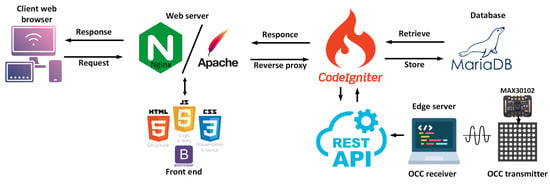
Figure 5.
Proposed OCC-IoMT platform scheme.
4. Experimental Setup
4.1. Experiment Setup
This experiment simulated the proposed system design in a small testbed resembling an IoMT system using OCC technology. We simulated multiple LED transmitters as the patients passed through several receiver cameras. The scenarios experiment setups are depicted in Figure 6. In scenario (a), one camera receiver detects two patients simultaneously. In scenario (b), one LED transmitter and two cameras are used as receivers to monitor patient movement based on Field of View (FOV). In this simulation, indoor location and health monitoring can be obtained by using two LED matrices and two cameras that are attached to a certain location. The received data are analyzed on the server and shown through a website interface.
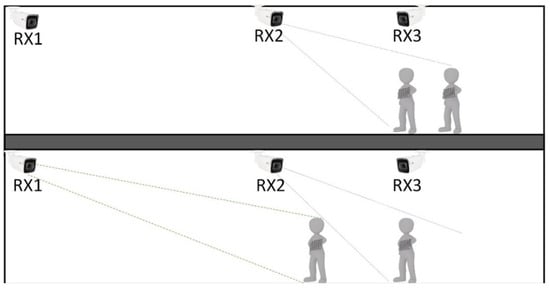
Figure 6.
Experiment setups for the different scenarios.
4.2. Hardware Setup
In the testbed setup, the mentioned sensors are employed, and the data produced will be modulated and mapped to the OCC LED 8 × 8 matrix as the transmitter. Arduino UNO is used as an intermediary device to connect the LED matrix transmitter and the sensors. Two webcams resembling the security camera (CCTV) in the building are used as OCC receivers. The LED utilized has 8 × 8 LEDs and will accommodate the localization anchor, SN, and health monitoring data. The overall process on the receiver side with the sample image is shown in Figure 7. Two webcams were used in this study, using the Brio UHD Pro Camera, manufactured by Logitech International S.A. in Lausanne, Switzerland, on the receiver side. Both LEDs are programmed using C++ for Arduino, while the receiver camera is controlled using Python version 3.11.
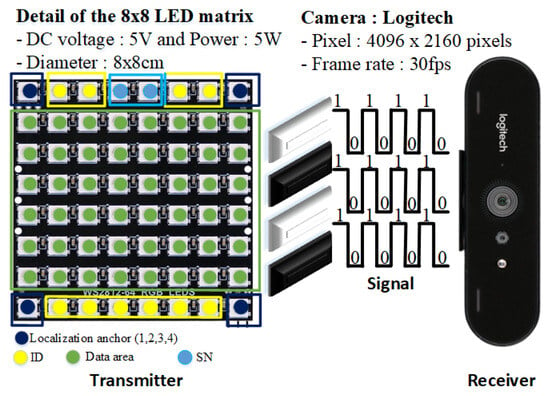
Figure 7.
The overall process on the receiver side.
4.3. Data Collection
This experiment collected several images to fine-tune the YOLOv8 object detection model in which the LED matrix is included in the images and captured several images in which the LED matrix was placed at different angles and positions. This technique is employed so that the object detection model is not overfitted and adapts to various LED placement scenarios, which is due to the irregular position of the LED matrix in real-world situations. Since different people’s heights are not always the same, the placement of the LED matrix will also be different.
We captured around 950 images for training and testing. An example of the training and testing data is shown in Figure 8. The LED matrix in the captured images will have different types of the SN set on the LED to simulate data readings on multiple patient schemes. We labeled the image using the CVAT tool by drawing a bounding box on the LED matrix. We split the images into training and validation with a ratio of 70% and 30%, respectively. The training is conducted on the hardware and software specified in Table 1. The training time is up to 45 min. To prevent overfitting, before taking images, we placed the LED matrix on several distance and angle variations. In addition, some images are set to have only a single LED matrix and some images are set to have two LED matrices at the same time.
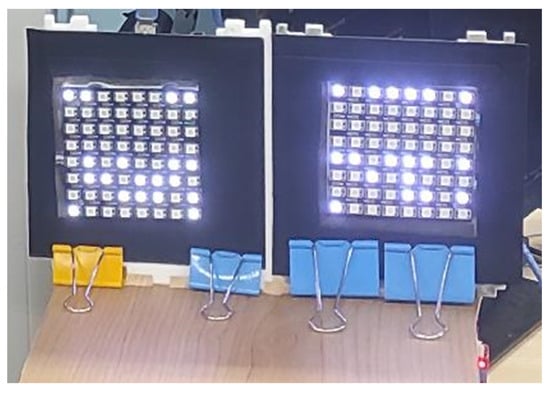
Figure 8.
Example of training and testing image data.

Table 1.
Hyperparameters, hardware, and software specifications for experiment.
For the health monitoring simulation, health monitoring data by simulating OCC communication in an indoor scenario were obtained. Two cameras are employed, and each camera has its identifier used to obtain time difference data and patient position data. The Python program that controls the camera is set to capture images at a rate of 30 frames per second. All health monitoring data, patient location, and timestamp data will be obtained and sent to the local server. The patient’s time and positioning calculation is performed on the server.
5. Experiment Result
5.1. Fine-Tuned YOLOv8 Object Detection Model’s Performance Result
As previously mentioned, multiple patients are represented by the usage of multiple LEDs, and those multiple LEDs are detected using the YOLOv8 object detection model. The fine-tuned object detection YOLOv8 model shows positive results. The model’s performance is measured using several evaluation metrics in object detection. This study utilized several common metrics such as IoU in Formula (1) for mean Average Precision (mAP) in Formula (2), precision in Formula (3), and recall in Formula (4). The formulas are detailed as follows.
The mean Average Precision (mAP) formula is written as Equation (5)
On an IoU of 0.5, the fine-tuned model achieved 0.96 mAP. Through the validation dataset, it is shown that the model has high confidence in detecting the LED matrix transmitter correctly. The other metrics, precision, and recall also show good results of 0.97 and 0.94, respectively, indicating the good performance of the trained weights. Based on this evaluation result, the model can detect the LED matrix for real-time implementation.
Consequently, the explained simulation also demonstrates significant performance in detecting the LED matrix transmitters. As highlighted in each scenario, the detection model can detect both single and multiple LED matrix transmitters. In addition, at various angles, the object detection model locates the LED transmitter precisely. Furthermore, as later shown in the simulation results, on a smaller LED matrix, the object detection model can locate the LED matrix accurately.
5.2. First Scenario: Tracking Multiple Patients at Similar Locations
This section conducts trial scenarios to verify the effectiveness of the system and simulate two transmitters representing two different patients. Figure 9 shows the setup of the OCC-IoMT system featuring two transmitters (TX) and a receiver (RX) specially designed for continuous and real-time patient health monitoring.

Figure 9.
Setup of the OCC-IoMT system featuring two TXs and one RX (the first scenario).
In this setup, the two transmitters are represented by patients One and Two. Each patient is equipped with a matrix LED that transmits health information, such as oxygen saturation, heart rate, and body temperature as well as the value of the panic button. The receiver in this system is a camera functioning similar to a CCTV, continuously monitoring and recording data sent by both transmitters. This camera not only captures data but also processes it for transmission to the edge server. The edge server, which is shaped like a personal computer, plays a vital role in this system. It is responsible for managing data received from the receiver, processing it, and ensuring its availability to the medical team. This system operates patient health data, which are sent through the matrix LED on each transmitter. The camera, acting as the receiver, is equipped with the ability to detect and differentiate both patients (two transmitters) simultaneously. This approach is achieved using the YOLO algorithm and the SN displayed on the LED matrix to identify each patient. Furthermore, the system can determine the patient’s location based on the camera ID. This allows monitoring of the location and duration of the patient’s presence within the camera’s range. Data obtained from both patients are then stored in the database via a REST API, ensuring the security and availability of information for further analysis. Figure 10 illustrates the results of implementing the OCC-IoMT system. Figure 10a shows the detection performed by the YOLO algorithm, depicting how the system can accurately identify and monitor two patients simultaneously. Figure 10b displays the database containing data received from both patients. Figure 10c,d shows the patient-accessible web interface. This web interface provides real-time information about the patient’s condition and their location based on the last camera that detected them.
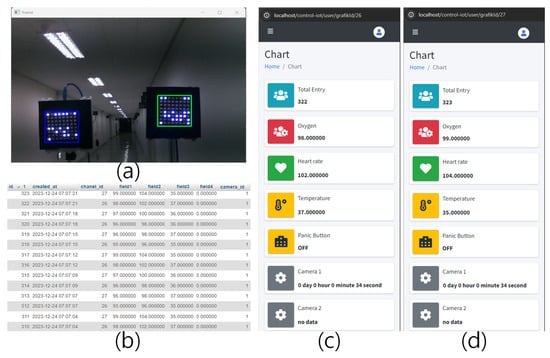
Figure 10.
The results of implementing the OCC-IoMT system. (a) The detection performed by the YOLO algorithm, depicting how the system can accurately identify and monitor two patients simultaneously; (b) the database containing data received from both patients; (c,d) the patient-accessible web interface (the first scenario).
5.3. Second Scenario: Patient Position Tracking Based on Different Camera Locations
The second scenario of the OCC-IoMT system, which is designed for patient health monitoring, focuses on a setup involving a TX with a matrix LED and two RX-using cameras. The critical aspect of this setup is the operation of both cameras based on their FOV, which provides a deeper understanding of how the system effectively monitors patients who move between positions.
Figure 11 provides a detailed setup of the OCC-IoMT system featuring one TX and two RX. Here, the transmitter is represented by a patient moving from one point to another. The patient is equipped with a device containing a matrix LED that transmits vital health data such as heart rate, oxygen saturation, and body temperature in real time, as well as the value of the panic button. For monitoring purposes, two cameras function like a CCTV, each with an FOV. This setup allows the cameras to alternately monitor the patient as they move from one FOV to another, ensuring continuous, gap-free monitoring, even as the patient moves. The first camera monitors the patient until they move out of its FOV, at which point the second camera takes over. This capability ensures that no information is missed as the patient moves within the monitoring area, and it allows for tracking the patient’s location based on the identification of the camera that detects them, demonstrating the system’s flexibility in accommodating patient movement and providing accurate, continuous data for medical teams.
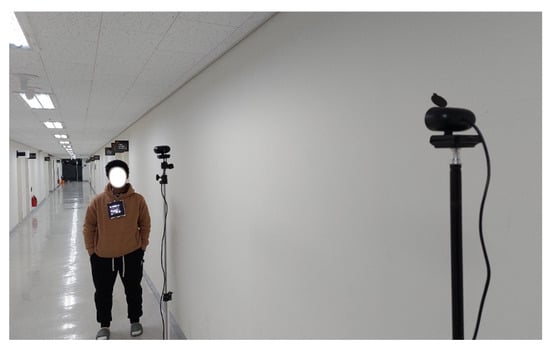
Figure 11.
Setup of the OCC-IoMT system featuring one transmitter (TX) and two receivers (RX).
Similar to the first scenario, the YOLO algorithm is utilized for patient detection and tracking. This algorithm enables the cameras to efficiently recognize and track the movement of patients from one FOV to the next. Once the data are collected, they are stored in a database using REST API, ensuring data integrity and accessibility.
Figure 12 displays the results of implementing the OCC-IoMT system. Figure 12a illustrates the detection performed by the YOLO algorithm in the first receiver’s FOV. Figure 12b shows the patient moving out of the first receiver’s FOV and then being detected by the second receiver, demonstrating how the system identifies and tracks the patient’s movement and the transition of FOV from the first receiver to the second. Figure 12c presents a view of the database, displaying the data received from both receivers. Lastly, Figure 12d showcases a web interface accessible to patients, providing real-time information about patients.
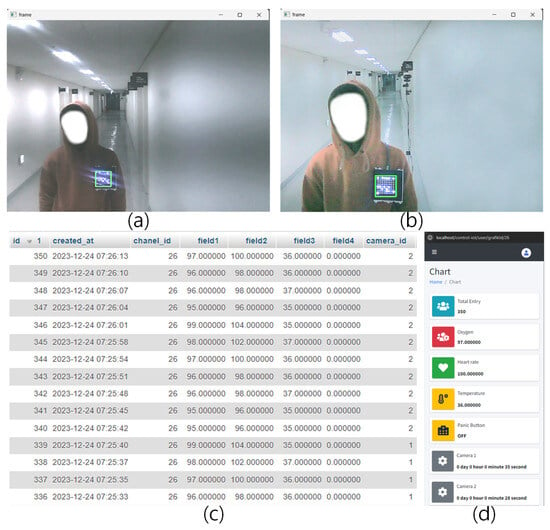
Figure 12.
Results of implementing the OCC-IoMT system. (a) the detection performed by the YOLO algorithm in the first receiver’s FOV; (b) the patient moving out of the first receiver’s FOV and then being detected by the second receiver, demonstrating how the system identifies and tracks the patient’s movement and the transition of FOV from the first receiver to the second; (c) a view of the database, displaying the data received from both receivers; and (d) a web interface accessible to patients, providing real-time information about patients (the second scenario).
The OCC-IoMT system effectively demonstrates real-time health monitoring in two distinct scenarios. Scenario one involves two patients (transmitters), each with a matrix LED transmitting vital health data, and a single camera (receiver) processing this data using the YOLO algorithm and relaying it to an edge server for medical team access. This setup ensures continuous monitoring and data accuracy. Scenario two focuses on a single patient moving between two cameras (receivers), each covering a different FOV. This arrangement allows for seamless monitoring as the patient moves, with each camera capturing data as the patient enters its FOV. Both scenarios highlight the system’s flexibility and efficiency in tracking patient health data, ensuring no information loss, and maintaining data integrity through real-time processing and storage. This advanced system exemplifies the potential of IoMT in enhancing patient care and monitoring.
Table 2 presents a comparison of functionalities across three different systems. It can be observed that the generated OCC method is capable of competing with existing technologies such as Bluetooth and Wi-Fi. Additionally, the proposed method, based on the IoT platform, can display patient data in real-time with a greater number of sensor detections. Furthermore, the OCC system excels in the areas of security and privacy as it transmits light as the signaling medium, making it immune to hacking during data transmission. However, the visibility of this system is not efficient when patients are out of the camera’s range or the transmitter is not visible to the receiver, preventing the capture of information from each patient. By using this proposed system, this issue can be addressed. As mentioned before, in this system, when one camera is unable to obtain data from the transmitter, other nearby cameras can receive the data.

Table 2.
Comparison of functionalities among the three different systems.
6. Conclusions
The IoMT is a promising technology that can speed up the process of medical activities and leverage its quality. Thus, this study proposes OCC in the IoMT system. Unlike common communication methods, OCC employs optical light to transmit data. In OCC, the transmitters are devices that emit light, including an LED array and a camera as the receiver. OCC has several advantages over other communications, such as radio frequency, which can be used in health monitoring. Therefore, a system that integrates OCC into the IoMT system was proposed.
In the proposed IoMT system, OCC transmits data from body sensors through several camera receivers to the cloud server. This system also takes advantage of security cameras commonly used in the last decades in many buildings to track the indoor location of patients. The data obtained from the OCC camera are then forwarded to the system and processed on the server, which is then shown on the client’s interface through a website. The data can serve as a reference for medical staff to take further action. Furthermore, the location of the patient can be tracked in real-time.
Consequently, a simulation to obtain the patient’s location based on the camera in an indoor environment was conducted and multiple patients’ OCC systems to obtain data from multiple patients using multiple LED arrays through the YOLOv8 object detection model were simulated. The developed IoMT system can receive data in parallel from the two transmitters. This system also tracked the patient’s location in real time through the cameras. Based on the simulation conducted, OCC can use the IoMT system to track patients’ real-time health conditions.
OCC has great potential in the future as a method for communication systems, especially in the IoT fields. Future studies should focus on a more comprehensive study on OCC in IoMT systems by integrating OCC for IoMT in larger-scale healthcare systems, which covers integration with other systems such as traffic and emergency systems. Furthermore, the potential of OCC and its implementation in other IoT systems, including industrial IoT, IoT in home automation, and smart agriculture, requires further research.
Author Contributions
Conceptualization, H.H. and O.S.S.; methodology, H.H. and M.R.A.N.; software, H.H., O.S.S., and M.R.A.N.; validation, H.H. and O.S.S.; formal analysis, H.H., O.S.S., and M.R.A.N.; investigation, H.H. and O.S.S.; resources, H.H. and M.R.A.N.; data curation, H.H. and O.S.S.; writing—original draft preparation, H.H. and M.R.A.N.; writing—review and editing, H.H., M.R.A.N., and H.N.; visualization, H.H. and O.S.S.; supervision, Y.M.J.; project administration, Y.M.J.; funding acquisition, Y.M.J. All authors have read and agreed to the published version of the manuscript.
Funding
This research was supported by the Ministry of Science and ICT (MSIT), South Korea, under the Information Technology Research Center (ITRC) support program (IITP-2023-2018-0-01396) supervised by the Institute for Information and Communications Technology Planning and Evaluation (IITP), and a National Research Foundation of Korea (NRF) grant funded by the Korean government (MSIT) (No. 2022R1A2C1007884).
Institutional Review Board Statement
Not applicable.
Informed Consent Statement
Not applicable.
Data Availability Statement
The data presented in this study are available in the article.
Conflicts of Interest
The authors declare no conflicts of interest.
References
- Cahyadi, W.A.; Chung, Y.H.; Ghassemlooy, Z.; Hassan, N.B. Optical Camera Communications: Principles, Modulations, Potential and Challenges. Electronics 2020, 9, 1339. [Google Scholar] [CrossRef]
- Villa, V.; Naticchia, B.; Bruno, G.; Aliev, K.; Piantanida, P.; Antonelli, D. IoT Open-Source Architecture for the Maintenance of Building Facilities. Appl. Sci. 2021, 11, 5374. [Google Scholar] [CrossRef]
- Li, X.; Pak, C.; Bi, K. Analysis of the development trends and innovation characteristics of Internet of Things technology—Based on patentometrics and bibliometrics. Technol. Anal. Strateg. Manag. 2020, 32, 104–118. [Google Scholar] [CrossRef]
- Duroc, Y. From Identification to Sensing: RFID Is One of the Key Technologies in the IoT Field. Sensors 2022, 22, 7523. [Google Scholar] [CrossRef]
- Kashani, M.H.; Madanipour, M.; Nikravan, M.; Asghari, P.; Mahdipour, E. A systematic review of IoT in healthcare: Applications, techniques, and trends. J. Netw. Comput. Appl. 2021, 192, 103164. [Google Scholar] [CrossRef]
- Syed, A.S.; Sierra-Sosa, D.; Kumar, A.; Elmaghraby, A. IoT in Smart Cities: A Survey of Technologies, Practices and Challenges. Smart Cities 2021, 4, 429–475. [Google Scholar] [CrossRef]
- Qiu, T.; Chi, J.; Zhou, X.; Ning, Z.; Atiquzzaman, M.; Wu, D.O. Edge Computing in Industrial Internet of Things: Architecture, Advances and Challenges. IEEE Commun. Surv. Tutor. 2020, 22, 2462–2488. [Google Scholar] [CrossRef]
- Kour, K.; Gupta, D.; Gupta, K.; Anand, D.; Elkamchouchi, D.H.; Pérez-Oleaga, C.M.; Ibrahim, M.; Goyal, N. Monitoring Ambient Parameters in the IoT Precision Agriculture Scenario: An Approach to Sensor Selection and Hydroponic Saffron Cultivation. Sensors 2022, 22, 8905. [Google Scholar] [CrossRef]
- Meng, Q.; Zhu, S. Developing IoT Sensing System for Construction-Induced Vibration Monitoring and Impact Assessment. Sensors 2020, 20, 6120. [Google Scholar] [CrossRef]
- Zhang, G.; Navimipou, N.J. A comprehensive and systematic review of the IoT-based medical management systems: Applications, techniques, trends and open issues. Sustain. Cities Soc. 2022, 82, 103914. [Google Scholar] [CrossRef]
- Jabraeil Jamali, M.A.; Bahrami, B.; Heidari, A.; Allahverdizadeh, P.; Norouzi, F. IoT Architecture. In Towards the Internet of Things: Architectures, Security, and Applications; EAI/Springer Innovations in Communication and Computing; Springer: Cham, Switzerland, 2020; pp. 9–31. [Google Scholar]
- Sumathi, D.; Poongodi, T. IoT network architecture and design. In Internet of Things; Prakash, K.B., Ed.; Walter de Gruyter GmbH and Co KG: Berlin, Germany; Boston, MA, USA, 2020; pp. 63–84. [Google Scholar]
- Islam, M.M.; Nooruddin, S.; Karray, F.; Muhammad, G. Internet of Things: Device Capabilities, Architectures, Protocols, and Smart Applications in Healthcare Domain. IEEE Internet Things J. 2023, 10, 3611–3641. [Google Scholar] [CrossRef]
- Kirmani, S.; Mazid, A.; Khan, I.A.; Abid, M. A Survey on IoT-Enabled Smart Grids: Technologies, Architectures, Applications, and Challenges. Sustainability 2023, 15, 717. [Google Scholar] [CrossRef]
- Bousdekis, A.; Lepenioti, K.; Apostolou, D.; Mentzas, G. A Review of Data-Driven Decision-Making Methods for Industry 4.0 Maintenance Applications. Electronics 2021, 10, 828. [Google Scholar] [CrossRef]
- Debauche, O.; Nkamla Penka, J.B.; Mahmoudi, S.; Lessage, X.; Hani, M.; Manneback, P.; Lufuluabu, U.K.; Bert, N.; Messaoudi, D.; Guttadauria, A. RAMi: A New Real-Time Internet of Medical Things Architecture for Elderly Patient Monitoring. Information 2022, 13, 423. [Google Scholar] [CrossRef]
- Askari, Z.; Abouei, J.; Jaseemuddin, M.; Anpalagan, A. Energy-Efficient and Real-Time NOMA Scheduling in IoMT-Based Three-Tier WBANs. IEEE Internet Things J. 2021, 18, 13975–13990. [Google Scholar] [CrossRef]
- Latha, R.; Vetrivelan, P. Wireless Body Area Network (WBAN)-Based Telemedicine for Emergency Care. Sensors 2020, 20, 2153. [Google Scholar]
- Ruby, D.; Divya, M.; Shaleen, C. Potential of Internet of Medical Things (IoMT) applications in building a smart healthcare system: A systematic review. J. Oral Biol. Craniofacial Res. 2022, 12, 302–318. [Google Scholar]
- Ahmed, M.F.; Hasan, M.K.; Shahjalal, M.; Alam, M.M.; Jang, Y.M. Design and Implementation of an OCC-Based Real-Time Heart Rate and Pulse-Oxygen Saturation Monitoring System. IEEE Access 2020, 8, 198740–198747. [Google Scholar] [CrossRef]
- Maatallaoui, A.; Touil, H.; Setti, L. The Impact of Radio Frequency (RF) Attacks on Security and Privacy: A Comprehensive Review. In Proceedings of the 6th International Conference on Networking, Intelligent Systems and Security, Larache, Morocco, 24–26 May 2023. [Google Scholar]
- Li, T.; Onodera, Y.; Nakayama, Y.; Hisano, D. Multi-Channel Authentication for Secure D2D using Optical Camera Communication. In Proceedings of the 2022 IEEE 19th Annual Consumer Communications and Networking Conference (CCNC), Las Vegas, NV, USA, 8–11 January 2022. [Google Scholar]
- Zhang, P.; Liu, Z.; Hu, X.; Sun, Y.; Deng, X.; Zhu, B.; Yang, Y. Constraints and Recent Solutions of Optical Camera Communication for Practical Applications. Photonics 2023, 10, 608. [Google Scholar] [CrossRef]
- Eöllős-Jarošíková, K.; Neuman, V.; Jurado-Verdú, C.M.; Teli, S.R.; Zvánovec, S.; Komanec, M. Long-distance indoor optical camera communication using side-emitting fibers as distributed transmitters. Opt. Express 2023, 31, 26980–26989. [Google Scholar] [CrossRef]
- Teli, S.R.; Eollosova, K.; Zvanovec, S.; Ghassemlooy, Z.; Komanec, M. Experimental Characterization of Fiber Optic Lighting—Optical Camera Communications. In Proceedings of the 2021 IEEE 32nd Annual International Symposium on Personal, Indoor and Mobile Radio Communications (PIMRC), Helsinki, Finland, 13–16 September 2021. [Google Scholar]
- Tsai, D.C.; Chang, Y.H.; Chow, C.W.; Liu, Y.; Yeh, C.H.; Peng, C.W.; Hsu, L.S. Optical camera communication (OCC) using a laser-diode coupled optical-diffusing fiber (ODF) and rolling shutter image sensor. Opt. Express 2022, 30, 16069–16077. [Google Scholar] [CrossRef]
- Teli, S.R.; Guerra-Yanez, C.; Icaza, V.M.; Perez-Jimenez, R.; Ghassemlooy, Z.; Zvanovec, S. Hybrid Optical Wireless Communication for Versatile IoT Applications: Data Rate Improvement and Analysis. IEEE Access 2023, 11, 55107–55116. [Google Scholar] [CrossRef]
- Salvi, S.; Geetha, V. LiCamIoT: An 8 × 8 LED Matrix Pattern to Camera Communication for LiFi-IoT Applications. In Proceedings of the 2022 IEEE Silchar Subsection Conference (SILCON), Silchar, India, 4–6 November 2022. [Google Scholar]
- Teli, S.R.; Chvojka, P.; Vítek, S.; Zvanovec, S.; Perez-Jimenez, R.; Ghassemlooy, Z. A SIMO Hybrid Visible-Light Communication System for Optical IoT. IEEE Internet Things J. 2022, 9, 3548–3558. [Google Scholar] [CrossRef]
- Salvi, S.; Geetha, V. A Nested Texture Inspired Novel Image Pattern Based Optical Camera Communication. IEEE Access 2022, 10, 109056–109067. [Google Scholar] [CrossRef]
- Chowdhury, M.Z.; Hossan, M.T.; Shahjalal, M.; Hasan, M.K.; Jang, Y.M. A New 5G eHealth Architecture Based on Optical Camera Communication: An Overview, Prospects, and Applications. IEEE Consum. Electron. Mag. 2020, 9, 23–33. [Google Scholar] [CrossRef]
- Hasan, M.K.; Shahjalal, M.; Chowdhury, M.Z.; Jang, Y.M. Real-Time Healthcare Data Transmission for Remote Patient Monitoring in Patch-Based Hybrid OCC/BLE Networks. Sensors 2019, 19, 1208. [Google Scholar] [CrossRef] [PubMed]
- Jurado-Verdu, C.; Guerra, V.; Matus, V.; Rabadan, J.; Perez-Jimenez, R. Convolutional autoencoder for exposure effects equalization and noise mitigation in optical camera communication. Opt. Express 2021, 29, 22973–22991. [Google Scholar] [CrossRef] [PubMed]
- Kharche, S.; Kharche, J. 6G Intelligent Healthcare Framework: A Review on Role of Technologies, Challenges and Future Directions. J. Mob. Multimed. 2023, 19, 603–644. [Google Scholar] [CrossRef]
- Sitanggang, O.S.; Nguyen, V.L.; Nguyen, H.; Pamungkas, R.F.; Faridh, M.M.; Jang, Y.M. Design and Implementation of a 2D MIMO OCC System Based on Deep Learning. Sensors 2023, 23, 7637. [Google Scholar] [CrossRef]
- Nguyen, H.; Tran, D.H.; Nguyen, V.L.; Chung, B.D.; Jang, Y.M. Design and Implementation of RS-OFDM scheme for Optical Camera Communication based on Deep Learning. In Proceedings of the 2023 International Conference on Artificial Intelligence in Information and Communication (ICAIIC), Bali, Indonesia, 20–23 February 2023. [Google Scholar]
- Shahjalal, M.; Hasan, M.K.; Chowdhury, M.Z.; Jang, Y.M. Smartphone Camera-Based Optical Wireless Communication System: Requirements and Implementation Challenges. Electronics 2019, 8, 913. [Google Scholar] [CrossRef]
- Yücel, M.; Açikgöz, M. Optical Communication Infrastructure in New Generation Mobile Networks. Fiber Integr. Opt. 2023, 42, 53–92. [Google Scholar] [CrossRef]
- Diwan, T.; Anirudh, G.; Tembhurne, J.V. Object detection using YOLO: Challenges, architectural successors, datasets and applications. Multimed. Tools Appl. 2023, 82, 9243–9275. [Google Scholar] [CrossRef] [PubMed]
- Pham, M.; Courtrai, L.; Friguet, C.; Lefèvre, S.; Baussard, A. YOLO-Fine: One-Stage Detector of Small Objects Under Various Backgrounds in Remote Sensing Images. Remote Sens. 2020, 12, 2501. [Google Scholar] [CrossRef]
- Ansari, M.F.; Lodi, K.A. A survey of recent trends in two-stage object detection methods. In Proceedings of the Renewable Power for Sustainable Growth: Proceedings of International Conference on Renewal Power (ICRP 2020), Rajouri, India, 17–18 April 2020. [Google Scholar]
- Terven, J.; Córdova-Esparza, D.M.; Romero-González, J.A. A Comprehensive Review of YOLO Architectures in Computer Vision: From YOLOv1 to YOLOv8 and YOLO-NAS. Mach. Learn. Knowl. Extr. 2023, 5, 1680–1716. [Google Scholar] [CrossRef]
- Zhang, Y.; Xiao, H. Bluetooth-Based Sensor Networks for Remotely Monitoring the Physiological Signals of a Patient. IEEE Trans. Inf. Technol. Biomed. 2009, 13, 1040–1048. [Google Scholar] [CrossRef]
- Chang, C.S.; Wu, T.H.; Wu, Y.C.; Han, C.C. Bluetooth-Based Healthcare Information and Medical Resource Management System. Sensors 2023, 23, 5389. [Google Scholar]
- Gonal, J.S.; Patil, M.M.; Jadhav, A.S.; Pawar, R.V. Wireless Patient Health Monitoring System using Internet of Things and Mobile device. In Proceedings of the 2023 Third International Conference on Artificial Intelligence and Smart Energy (ICAIS), Coimbatore, India, 2–4 February 2023. [Google Scholar]
- Kumar, S.P.; Samson, V.R.R.; Sai, U.B.; Rao, P.L.S.D.M.; Eswar, K.K. Smart health monitoring system of patient through IoT. In Proceedings of the International Conference on I-SMAC (IoT in Social, Mobile, Analytics and Cloud) (I-SMAC), Palladam, India, 10–11 February 2017. [Google Scholar]
Disclaimer/Publisher’s Note: The statements, opinions and data contained in all publications are solely those of the individual author(s) and contributor(s) and not of MDPI and/or the editor(s). MDPI and/or the editor(s) disclaim responsibility for any injury to people or property resulting from any ideas, methods, instructions or products referred to in the content. |
© 2024 by the authors. Licensee MDPI, Basel, Switzerland. This article is an open access article distributed under the terms and conditions of the Creative Commons Attribution (CC BY) license (https://creativecommons.org/licenses/by/4.0/).